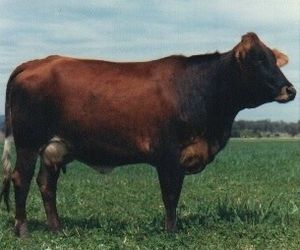Australian Friesian Sahiwal facts for kids

Australian Friesian Sahiwal cow
|
|
| Country of origin | Queensland, Australia |
|---|---|
| Type | Sahiwal & Holstein-Friesian |
| Use | Dairy production |
| Traits | |
| Color | Black/White/Red&Black |
The Australian Friesian Sahiwal (AFS) is a special type of dairy cow from Australia. Its development started in the 1960s in Queensland. This breed was created by mixing two other cattle types: the Sahiwal from Pakistan and the Holstein.
The AFS breed was specifically designed to live well in hot, wet, or "tropical" places. These cows are very good at handling heat, humidity, and even ticks and other tiny pests. They can produce about 3,000 litres of milk during each lactation period, even in tropical areas.
Because they are so good at living in warm climates, AFS cows have been sent to many tropical countries. You can find them in places like South East Asia, Central and South America, and the Indian sub-continent. This breed helps these countries produce milk and support their livestock industries.
Contents
Similar Cows in Other Countries
In Brazil, there's a similar type of cow called "Girolanda". It's a mix of Holstein and Gir cattle. The Girolanda has been used for many years in Brazil to produce milk successfully.
How the AFS Breed Was Developed
Scientists from the CSIRO and the Queensland Department of Primary Industries (QDPI) started working on the AFS breed in the 1960s. Their goal was to create cows that could resist ticks and handle hot weather.
They created the AFS by mixing 50% Holstein-Friesian genes with 50% Sahiwal genes. Many studies showed that this mix was the best for producing milk and having long lactation periods. The AFS cows were able to overcome common problems that other cattle faced. For example, they were better at letting down milk for machines, even without a calf present.
Research in Bangladesh found that AFS cows had a shorter gestation period (pregnancy time). They also had good breeding performance. This made them perfect for countries needing to grow their livestock. In India, scientists also found that Sahiwal cattle were great for creating new, strong dairy breeds like the AFS.
Living in Tropical Conditions
One of the best things about the AFS breed is its ability to live well in tropical places. This is very important for countries with hot and humid weather. High humidity can affect a cow's body temperature and how much milk it produces.
Heat-Resistant Cows
Scientists learned that things like humidity, wind, rain, and day length can affect how much milk fat cows produce. So, they developed the AFS breed to handle these environmental challenges. The mix of Bos taurus (like Holstein) and Bos indicus (like Sahiwal) genes helps them adapt to tropical conditions.
AFS cows produce good amounts of milk even in hot, tropical climates. This was the main goal when the QDPI created them. They wanted to combine the heat-adapting traits of the Bos Indicus with the great milk production of the Bos taurus. While they do well in hot places, studies have shown that AFS cows can also thrive in colder weather. For example, in Thailand, their milk production was even higher in rainy and winter seasons.
This makes AFS an ideal breed compared to pure breeds. The Holstein-Friesian is known for milk in cooler areas. The Sahiwal is best for tropical areas. By mixing them, the AFS gets the best qualities from both. This helps them adjust to different tropical climates. Cows need to have good heat tolerance. This means they can control their metabolism in hot conditions.
Tick-Resistant Cows
Besides handling heat, AFS cows are also good at resisting ticks. Ticks can carry diseases that harm cattle. The mix of Holstein-Friesian and Sahiwal cattle genes gives them stronger resistance to tropical diseases and parasites.
Sahiwal cattle are especially known for their good milk production, high heat tolerance, and resistance to diseases and parasites. Scientists compared Sahiwal and Holstein cattle to see which was better at resisting ticks. They found that Sahiwal calves were much more resistant to a tick-borne disease called Theileria annulata. This is because Sahiwal cattle come from Punjab, India, where these ticks are common. Over time, they became more resistant.
Milk Production
The AFS breed is known for its good milk production, even in tropical conditions. A study in Thailand showed that AFS cows produced good amounts of milk despite the humidity. However, in very hot summer months, milk production and reproduction sometimes went down.
In Malaysia, a study compared AFS cows from Malaysia, Australia, and New Zealand. It found that over 39% of the AFS cows produced more milk than local breeds. When the AFS breed was first developed, they produced less milk than pure Holstein-Friesians. But overall, AFS cows were still considered the best choice because of their ability to handle tough conditions.
Scientists worked hard to make sure the AFS cows produced milk consistently. They used embryos from the best milk-producing cows to develop the breed further. While most studies show AFS cows have good milk production, some early research noted that some Sahiwal Friesian cows had problems with milk production at the start of their lactation. However, scientists continued to improve the breed.
The Holstein-Friesian cows are known for having excellent genes for milk production. Scientists found that with small changes to these genes, they could get even better milk production and reproductive performance. This shows how important good reproductive health is for milk production. While Holstein-Friesian cows are great milk producers, they can sometimes be more likely to get diseases like foot and mouth disease. The AFS breed aims to combine the best of both worlds: good milk production and strong resistance to diseases and tough climates.
Images for kids



